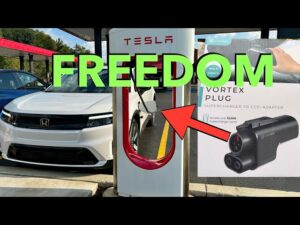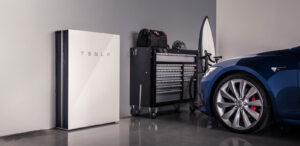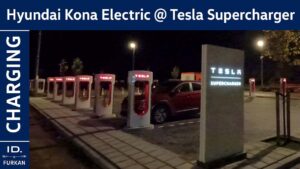Your Tesla might charge at 16A due to certain limitations. These can include charging station constraints or vehicle settings.
Let’s dive deeper into the reasons behind this issue. Owning a Tesla is a thrilling experience. But charging problems can be frustrating. If your Tesla charges at 16A instead of the expected 32A, you’re not alone. This issue is common among Tesla owners.
Understanding the reasons can help you resolve it. Sometimes, the charging station only supports 16A. Other times, your car settings might need adjustment. Electrical issues at home can also play a role. Identifying the exact cause is crucial. It ensures efficient charging and better performance. This guide will walk you through potential reasons and solutions. Let’s explore what might be going wrong with your Tesla charging process.
Common Charging Rates For Tesla
Tesla has revolutionized the electric vehicle market with its sleek design and cutting-edge technology. But when it comes to charging your Tesla, understanding the common charging rates can make all the difference in optimizing your experience. You might wonder why your Tesla is charging at 16A instead of the expected 32A. Let’s delve into the details and uncover the reasons behind these charging rates.
Standard Charging Levels
Charging levels for Tesla typically range from Level 1 to Level 3. Level 1 uses a standard household outlet, providing a slow charge that’s perfect for overnight charging. Level 2 uses a 240V outlet, which is more common for home charging and public stations. This level usually offers faster charging, often reaching 32A depending on your setup.
Public charging stations and Tesla Superchargers offer Level 3 charging. These are designed for rapid charging, getting your Tesla ready in a fraction of the time. If you’re mainly using Level 2 and your Tesla is charging at 16A, there might be factors affecting the amperage.
Factors Affecting Amperage
Several factors can impact the amperage during charging. One common issue is the power supply. If your electrical circuit can’t handle 32A, your Tesla will automatically adjust to a lower amperage to prevent overloading.
Check your charging cable and connector. A damaged or incompatible cable can affect charging rates. Ensure your equipment is in top shape to achieve optimal charging.
Temperature can also play a role. Extreme hot or cold conditions might reduce charging efficiency. Consider this if you’re charging in a garage or an outdoor setting.
Have you ever wondered if your charging habits affect your Tesla’s performance? The charging rates might be a hint. Would your charging setup benefit from an upgrade? Addressing these factors can lead to faster and more efficient charging.
Understanding why your Tesla charges at certain rates is crucial. Adjustments might be necessary to ensure you get the most out of your Tesla charging experience. Could simple tweaks transform your charging routine?
Check The Charger And Cable
Experiencing a Tesla charging at 16A instead of 32A can be puzzling. Sometimes, the issue might be as simple as your charger or cable. By examining these components closely, you can often find the root of the problem and get back to faster charging speeds.
Inspect Cable Connections
Start by checking the cable connections. Ensure that the cable is securely plugged into both the Tesla and the power source. A loose connection can easily limit the charging current.
It’s not uncommon for dirt or debris to accumulate in the connectors. This can cause poor contact and reduce charging efficiency. Cleaning the connectors with a dry cloth can sometimes solve the issue.
Evaluate Charger Compatibility
Consider whether your charger is compatible with your Tesla’s charging capabilities. Not all chargers are created equal, and some might not support 32A charging.
Double-check the specifications of your charger. It should clearly state the maximum amperage it can deliver. If it’s only designed for 16A, upgrading to a compatible charger will be necessary for faster charging.
You might also want to think about whether your home electrical setup supports higher amperage. If your home wiring can’t handle 32A, even the best charger won’t help.
Have you ever assumed your charger was working at full capacity, only to find out it wasn’t compatible? Such insights can save you time and money.
Examine The Power Supply
Charging your Tesla at home can be a convenient and cost-effective solution, but it can sometimes come with unexpected hurdles, like your car charging at 16A instead of 32A. One of the first steps you should take in troubleshooting this issue is to examine the power supply. This is crucial because the power supply can directly affect the charging speed and efficiency. Let’s delve into the specifics.
Assess Home Electrical System
Your home electrical system is the backbone of your Tesla’s charging capabilities. Are you aware of its capacity? Many homes might not be equipped to handle higher amperage, which can restrict your car from charging at its optimal rate.
Consider a time when your home appliances ran simultaneously and tripped the circuit. This could indicate that your electrical system is already operating near its limit. Upgrading the system might be necessary to support a 32A charge.
Are there any other high-power devices connected to the same circuit? If your air conditioning or another appliance is drawing power, it might limit the available capacity for charging your Tesla. You might need to allocate dedicated circuits for your car.
Identify Circuit Breaker Issues
The circuit breaker is designed to protect your electrical system from overloads. If your Tesla is charging at a lower amperage, it’s worth checking if the circuit breaker is tripping frequently.
Have you ever noticed flickering lights or appliances turning off unexpectedly? This could be a sign that your circuit breaker is struggling with the load. A malfunctioning breaker might need replacing or upgrading to handle 32A safely.
Investigate whether the circuit breaker is appropriately rated for the charging station. Sometimes, the breaker may not match the station’s specifications, leading to reduced charging speeds. What’s your breaker’s rating? Confirm it aligns with your Tesla’s charging requirements.
Examine these components carefully, and you might find the answer to your charging dilemma. Can you boost your Tesla’s charging efficiency by addressing these power supply concerns? Dive into these details and take proactive steps to improve your charging experience.

Credit: www.reddit.com
Tesla Vehicle Settings
Tesla vehicles offer advanced settings to enhance your driving experience. Adjusting these settings can optimize your charging process. If your Tesla charges at 16A instead of 32A, vehicle settings might be the reason. Understanding Tesla’s settings is crucial for efficient charging. Let’s explore this further.
Adjust Charging Preferences
Your Tesla’s charging preferences affect how power is delivered. The charge current setting is crucial. If set low, your car charges at reduced amperage. Locate this setting in your Tesla’s touchscreen. Navigate to ‘Charging’ under ‘Controls.’ Ensure the charge current is set to maximum. This allows the car to draw full power, enhancing charging speed.
Sometimes, a lower setting is chosen automatically. This can happen due to environmental conditions or past settings. Always check these preferences for optimal charging. Changing these settings can make a significant difference.
Review Software Updates
Tesla frequently releases software updates to improve functionality. These updates can affect charging behavior. Ensure your vehicle has the latest software version. Access the software update section in your Tesla’s touchscreen. Click on ‘Software’ under ‘Controls.’
Software updates may reset charging settings. After updating, review all settings to ensure they align with your needs. Keeping your software updated can enhance performance. It ensures your Tesla operates efficiently.
External Environmental Factors
Your Tesla charging at 16A instead of 32A might be due to external environmental factors. Cold temperatures or damaged cables can affect charging efficiency. Always check your charging setup and conditions for optimal performance.
When your Tesla suddenly decides to charge at 16A instead of the expected 32A, it can be both puzzling and frustrating. One often-overlooked reason is the impact of external environmental factors. These factors can play a significant role in how effectively your electric vehicle charges. Let’s dive into a few key elements that might be affecting your charging speed.Temperature Considerations
Temperature can have a surprising effect on charging speeds. Cold weather can be a major culprit, as it affects the battery’s ability to accept charge efficiently. Your Tesla might automatically reduce the charging current to protect the battery when it detects cooler temperatures. Even in warmer climates, if your car is sitting in direct sunlight, it can cause the battery to heat up, leading to reduced charging efficiency. Parking in a shaded area or a garage can help maintain an optimal battery temperature.Impact Of Weather Conditions
Weather conditions go beyond just temperature. Rain, humidity, and even wind can influence charging performance. Wet conditions may affect the electrical connections, leading to safety systems reducing current flow to prevent potential hazards. Have you ever noticed how your car’s charging speed varies during a windy day? The wind can cool the battery, affecting the thermal management system and consequently altering the charging process. Observing these patterns can help you anticipate and adjust for better charging efficiency. Considering these factors can provide insights into why your Tesla might not be charging at its full potential. Have you noticed any other environmental factors impacting your charging experience? Share your observations in the comments!Credit: teslamotorsclub.com
Potential Hardware Problems
If your Tesla charges at 16A instead of 32A, hardware issues might be at play. These problems can affect the charging efficiency and speed. Identifying and understanding these issues can help you address them effectively. Below, we delve into potential hardware problems.
Battery Management System
The Battery Management System (BMS) ensures safe and efficient charging. It monitors the battery’s health and adjusts the charging rate as needed. A malfunction in the BMS might restrict the current to 16A. This system protects the battery from damage due to overcharging. If the BMS detects any anomaly, it may reduce the charge rate.
Internal Charging Components
Internal charging components play a vital role in power conversion. They transfer energy from the charger to the battery. Faulty components could limit the charging rate. Damaged wires or connectors might disrupt the power flow. Regular maintenance checks can prevent issues with these components. Ensuring they function properly can restore optimal charging performance.
Contacting Tesla Support
Experiencing a Tesla charging at 16A instead of 32A can be puzzling. Contact Tesla Support to identify possible issues. They can help diagnose problems with your charging setup or vehicle settings. Understanding the cause can lead to efficient solutions and restore optimal charging speed.
Are you frustrated because your Tesla is charging at 16A instead of 32A? This problem can certainly put a damper on your plans. But don’t worry; Tesla Support is there to help. They can guide you through troubleshooting steps or even resolve the issue remotely. Understanding when and how to contact them can save you time and energy.When To Seek Professional Help
If you’ve tried adjusting settings and inspecting connections without success, it might be time to reach out to Tesla Support. Sometimes the issue is more complex, involving the car’s internal systems or software updates. A sudden drop in charging speed could signal a deeper issue that requires professional attention. You don’t want to risk damaging your vehicle or voiding warranties by attempting complex fixes yourself. If you’re unsure, ask yourself: Is my charging station functioning properly? Have I noticed any error messages? If the answer is yes, it’s wise to contact Tesla Support.Information To Provide Support
When contacting Tesla Support, ensure you have the necessary information at hand. This includes your vehicle identification number (VIN) and the version of your Tesla app. Details about your charging setup are crucial. Describe the type of charger you’re using and any recent changes to your charging environment. Document any error messages or unusual behavior from your car. This helps technicians quickly pinpoint the issue. Being prepared can expedite the resolution process, allowing you to get back to enjoying your drive sooner. Have you ever wondered what happens behind the scenes when you call support? Understanding your car’s needs and providing accurate information can make all the difference.
Credit: www.amazon.com
Preventative Measures
Tesla charging issues can stem from various factors, including power supply limitations or charging equipment faults. Regularly checking your charging setup ensures optimal performance and prevents common issues. Simple maintenance, like cleaning connectors, can often solve reduced charging speeds.
If your Tesla is charging at 16A instead of the expected 32A, it might feel like waiting for a slow internet connection to buffer your favorite show. Frustrating, right? Understanding and implementing preventative measures can save you from this exasperation. By adopting a proactive approach, you can ensure your Tesla charges efficiently every time.Regular Maintenance Tips
Regular check-ups are crucial for your Tesla’s charging system. Inspect your charging cables for any wear and tear. Damaged cables can lead to reduced amperage and slower charging times. Clean the connectors regularly. Dirt and debris can interfere with the connection, causing the charging rate to drop. Use a soft cloth to wipe them down gently. Schedule routine software updates. Tesla often releases updates that can enhance charging efficiency. Ensuring your car’s software is up-to-date can prevent unnecessary charging issues.Upgrading Charging Equipment
Consider investing in a high-quality charging station. A robust home charger can provide a more reliable 32A charge compared to a standard outlet. Think about the wiring in your home. Outdated or insufficient wiring can limit the amperage your Tesla receives. Consult with a certified electrician to evaluate and upgrade your home’s wiring if necessary. Look into smart charging solutions. These devices can optimize the charging process, ensuring your Tesla receives the correct amperage. They can also provide insights into your charging habits, helping you spot potential issues early. Have you ever experienced the frustration of a slow charge just before a long trip? Share your story with others and learn from their experiences. By taking these preventative steps, you can enjoy the full benefits of your Tesla without the charging hiccups.Frequently Asked Questions
Why Is My Tesla Only Charging At 16 Amps?
Your Tesla might charge at 16 amps due to a lower power source capacity or charging settings. Check your vehicle’s charging preferences and the power outlet’s capacity to ensure optimal charging. Also, verify the charging cable’s specifications for compatibility with higher amperage.
What Is The Difference Between 16a And 32a Tesla?
The difference between 16A and 32A Tesla chargers lies in their charging speed. A 32A charger offers faster charging, reducing the time needed to recharge the vehicle. The 16A charger takes longer to charge, making it suitable for overnight charging at home.
Both options are compatible with Tesla vehicles.
Why Won’t My Tesla Charge At 32 Amps?
Your Tesla might not charge at 32 amps due to charging limits set in the car’s settings or electrical restrictions. Check for charging settings, software updates, and ensure your home charger supports 32 amps. Consult Tesla support for troubleshooting if the issue persists.
What Does 16a Mean On A Tesla?
16A on a Tesla refers to the maximum current the charging system can handle. This is crucial for home charging setups, as it impacts charging speed. Ensure compatibility with your home’s electrical capacity for efficient charging.
Conclusion
Understanding why your Tesla charges at 16A instead of 32A helps. It could be due to your charging equipment or settings. Check your charging cable for any issues. Also, ensure your Tesla settings allow 32A charging. Other factors like electricity supply can impact charging speed too.
Regularly inspect your home charging setup. Avoid potential problems by maintaining your charger and cables. Knowing these aspects ensures a smoother charging experience. Stay informed and keep your Tesla in top condition. Enjoy your efficient and eco-friendly ride. Happy driving!


